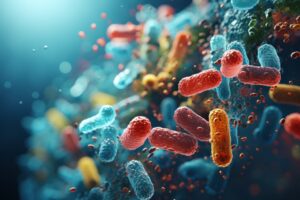
Researchers develop polymers that can kill bacteria
Canadian Plastics
Materials Research & DevelopmentScientists have created a new family of polymers capable of killing bacteria without inducing antibiotic resistance, which is a major step in the fight against superbugs like E. coli and MRSA.

E. coli bacterial strains. Image Credit: Adobe Stock/Alla
In the wake of the COVID-19 pandemic, the World Health Organization (WHO) isn’t running any unnecessary risks – it has identified the rapid emergence of antibiotic-resistant bacteria, or “superbugs,” as a global threat and has called for the urgent development of novel antibiotics to combat them. And for good reason: Every year, WHO officials say, antibiotic-resistant bacteria account for tens of millions of infections globally, and without new antibiotics even common injuries and infections harbour the potential to become lethal.
“Cationic polymers” – defined as macromolecules that possess positive charges, which can be either inherently in the polymer side chains and/or its backbone – are one promising class of bioactive agents that can be used in this context to kill bacteria, and an interdisciplinary team of U.S. researchers, led by Texas A&M University, have developed a new family of polymers capable of killing bacteria without inducing antibiotic resistance by disrupting the membrane of these microorganisms – a major step in the fight against superbugs like E. coli and Staphylococcus aureus (MRSA).
Working at the interface of organic chemistry and polymer science, the Michaudel Laboratory at Texas A&M – which is headed by Dr. Quentin Michaudel, an assistant professor in the department of chemistry and the lead investigator in the research – was able to synthesize the new polymer by carefully designing a positively charged molecule that can be stitched many times to form a large molecule made of the same repeating charged motif using a carefully selected catalyst called AquaMet. According to Dr. Michaudel, that catalyst was key to the whole project, given that it must tolerate a high concentration of charges and also be water-soluble – which is a feature he describes as uncommon for this type of process.
After achieving success, the Michaudel Laboratory put its polymers to the test against two main types of antibiotic-resistant bacteria – E. coli and MRSA – in collaboration with Dr. Jessica Schiffman and her team at the University of Massachusetts Amherst. Working at the interface of materials science and microbiology, Schiffman lab member and recent Ph.D. graduate Dr. Emily Diep developed investigative procedures – known as assays – which were used to evaluate how much of the cationic polymers was needed to kill the two strains of bacteria. The assays also evaluated the susceptibility of clinically relevant bacteria to the polymers.
While awaiting those results, Michaudel Laboratory researchers also tested their polymers’ toxicity against human red blood cells.
“A common issue with antibacterial polymers is a lack of selectivity between bacteria and human cells when targeting the cellular membrane,” Dr. Michaudel explained. “The key is to strike a right balance between effectively inhibiting bacteria growth and killing several types of cells indiscriminately. The new polymers we synthesized could help fight antibiotic resistance in the future by providing antibacterial molecules that operate through a mechanism against which bacteria do not seem to develop resistance.”
Dr. Michaudel says the team will now focus on improving the activity of its polymers against bacteria – specifically, their selectivity for bacterial cells versus human cells – before moving on to assays performed in vivo, or in a living organism. “We’re in the process of synthesizing a variety of analogs with that exciting goal in mind,” he said.
